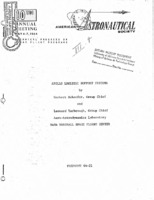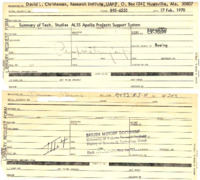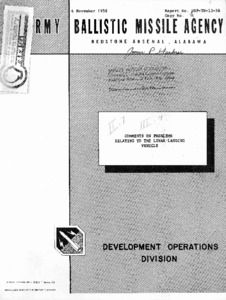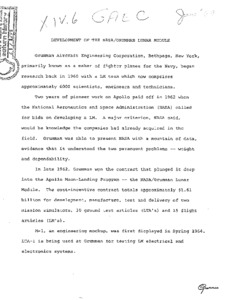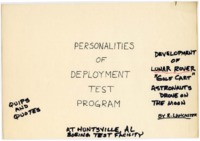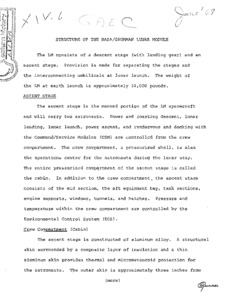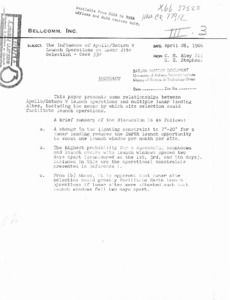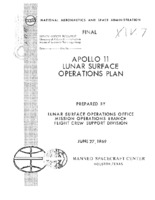
Browse Items (14 total)
Sort by:
-
"Apollo Logistic Support Systems."
According to an abstract found on the page following the title page, this paper includes "one possible conceptual definition of an early Apollo Logistics Support Systems (ALSS) is presented and various payloads for the system are briefly discussed. " It also discusses the Lunar Mobile Laboratory (MOLAB) and other considerations for a lunar scientific mission. -
"Apollo Logistics Support System (ALSS) Payloads Summary Report."
This report includes a summary of the major tasks performed by the Apollo Logistics Support System Payloads with an emphasis on the Lunar Mobile Laboratory (MOLAB). -
"Comments on Problems Relating to the Lunar-Landing Vehicle."
"This technical note concerns some of the problems encountered with the landing of a payload on the moon. The main problem areas such as guidance, velocity control and impact considerations are discussed. Although no final conclusions or designs are intended, it is hoped that the material presented will serve as a guide for future detailed work." -
"Development of the NASA/Grumman Lunar Module."
Paper regarding the actions and achievement of the Grumman Aerospace Corporation. -
"Personalities of Deployment Test Program at Huntsville, AL Boeing Test Facility: Quips and Quotes, Development of Lunar Rover 'Golf Cart' Astronauts Drove on the Moon, by R. Lancaster."
This album contains a series of photographs from the construction of the Lunar Roving Vehicle (LRV) at the Boeing test facility in Huntsville, Alabama. Ron Lancaster, a longtime Boeing engineer, added humorous speech bubbles and notes to the photographs, many of which depict himself and his colleagues. The album includes a group shot of the engineers with a completed LRV. -
"Structure of the NASA/Grumman lunar module."
Describes the structure and function of each part of the NASA Lunar Module -
"The Influence of Apollo/Saturn V Launch Operations on Lunar Site Selection: Case 330."
This paper presents some relationships between Apollo/Saturn V launch operations and multiple lunar landing sites, including the means by which site selection could facilitate launch operations. -
Final Apollo 11 Lunar Surface Operations Plan.
Prepared by the Lunar Surface Operations Office, Mission Operations Branch, Flight Crew Support Division. -
Oral History Interview With Edwin Pruitt
Edwin Pruitt is from a small town in Alabama. He went to Auburn University, and when he was a sophomore there, he applied to a co-op position. In this co-op, he was assigned to a flight-dynamics group. Edwin was not satisfied with this position, so he asked to be switched to another one. In this new co-op, he was able to drive around on the simulated moon surface. Some things he was also involved in was diving into the Neutral Buoyancy Simulator, flying on the KC-135, and he had the freedom to represent his group with other part of the center where he worked. After Edwin graduated from college, he got a job at GE Aerospace in Valley Forge. They had a contract with the Airforce to train the Airforce astronauts. He eventually got laid off from this position, and he next got a job at Teledyne Brown Engineering. After working there for a couple of years, he found a job at Matrix in Huntsville. After working here, he found a job at Essex working on proposals.Tags Oral History -
Oral History Interview With Steven Hall
Steven Hall was born in a small town in the north central part of Indiana. This town has about a population of 2,000 people. Steven graduated from Eastern High School in 1963, and then he enrolled in Aeronautical/Neurospace Engineering at Purdue University. There, he received his bachelor's degree in 1968. Steven originally became interested in man space-flight when he was just about 10 years old. At this age, he had no clue how he could get involved with the space station, but he knew that he wanted to get involved one day. After he graduated college, he was so ready to work at NASA, that he left his home town immediately to move down to Huntsville, AL to start working. When he began working at the Marshall Space Flight Center, he was shown how Human Factors Engineering worked. One of the first projects that Steven was able to work on was "Skylab" where they built a lot of the equipment that probed how humans responded to space, and how the body changes in space. He also worked on a program to design a vehicle to drive around the surface of the moon.Tags Oral History
